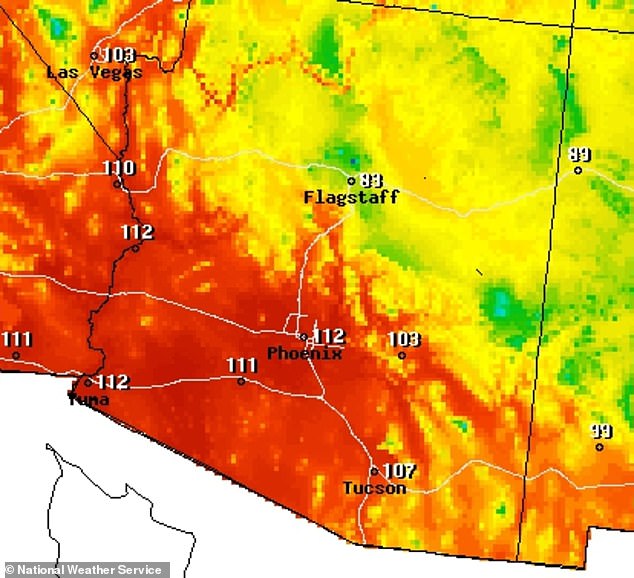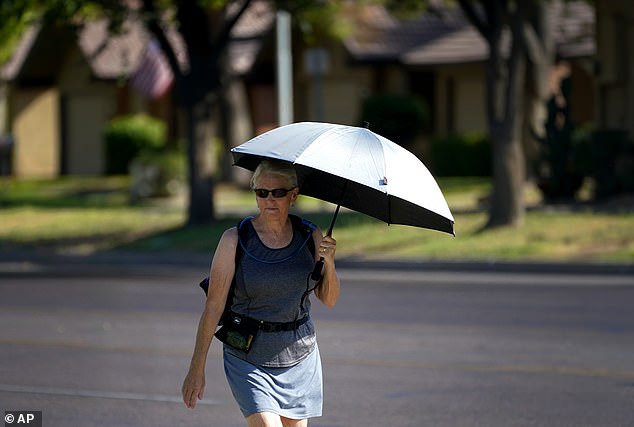Arizona hits new heat record after mercury hit 110F for FIFTY-FOUR days in a row
The Arizona city has set a new heat record after the mercury soared to a balmy 110F for 54 days in a row.
The sweltering summer of 2023 saw a historic heat wave that stretched from Texas through New Mexico and Arizona to the California desert.
Matt Salerno, a meteorologist with the National Weather Service, said the hot streak could reach 55 days.
“We have one day left,” he said.
An extreme heat warning remained in effect in the sweltering Sonoran Desert city, with forecast temperatures of 111 F on Sunday and 106 F on Monday.
Arizona set a new heat record with temperatures reaching 110F for 54 days, causing tires to melt, residents scrambling to extreme measures to stay fresh and


Videos posted to TikTok show the extent of the scorching heat, as one person recorded himself cooking an egg in the summer heat

A heat map of the area, taken on September 9

A scorching heat wave that continues to blow much of the US is so hot that even Arizona’s iconic cacti are dying out
Salerno said Phoenix has experienced its hottest three months since records began in 1895, including the hottest July and second-hottest August.
The daily average temperature of 97 F in June, July and August surpassed the previous record of 96.7 F set three years ago.
The average daily temperature was 102.7 F in July, Salerno said, and the daily average in August was 98.8 F.
In July, Phoenix also set a record with a streak of 31 days of highs at or above 110 F. The previous record of 18 consecutive days was set in 1974.
According to the World Meteorological Organization, last month was the warmest August on record worldwide.
It was also the second-warmest month on record, after July 2023. Scientists blame human-induced climate change with an added boost from a natural El Nino, a temporary warming of parts of the Pacific Ocean that pushes the weather across the whole world changes.
As of Saturday, Phoenix has counted 104 days with temperatures above 100 F this year, Salerno said. That compares to the average of 111 triple-digit days per year between 1991 and 2020.

Pictured: Dozens of people cool off in the waters of Oak Creek, providing an escape from the extreme heat in Sedona, Arizona, at Slide Rock State Park

The sun silhouettes the air traffic control tower at Phoenix Sky Harbor International Airport
Maricopa County, home to Phoenix and Arizona’s most populous county, also appears headed for an annual record for heat-related deaths.
Public health officials have confirmed 194 heat-related deaths this year as of September 2. Another 351 cases are under investigation.
Maricopa County confirmed 425 heat-related deaths in 2022.
A video posted to social media shows an Arizona resident resorting to desperate measures to stay calm.
Footage shows Heidi Lavon being sprayed by a powerful hose while outside in the hot temperatures.
Dressed in a red bikini, Nelly’s hit song It’s Getting Hot was played over the clip to illustrate the heat.
“Why is everyone so concerned about the weather here?” TikToker said Heidi Lavon.
Last month, 50 Cent postponed his show in Phoenix, Arizona after hearing that “dangerous” temperatures would hit the area.
The 48-year-old rapper announced that his August 28 show had been postponed after an excessive heat warning went into effect predicting a high of 116 degrees.
“Due to the extreme heat, tomorrow’s show in Phoenix, AZ is postponed. For anyone wanting a refund, please go to the point of purchase for instructions.
“I’ll be back in Arizona soon!” 116 degrees is dangerous for everyone (shrug emoji). #bransoncognac #lecheminduroi @thefinallaptour,” he captioned the post.


In Phoenix, residents used the dashboard of a car to bake cookies in the extreme heat
Earth has endured the Northern Hemisphere’s hottest summer on record, with a record warm August capping off a season of brutal and deadly temperatures, the World Meteorological Organization said.
Last month was not only by far the warmest August that scientists have ever measured with modern equipment, it was also the second warmest month recorded, after July 2023, WMO and the European climate agency Copernicus announced on Wednesday.
August was about 2.7 degrees Fahrenheit warmer than pre-industrial averages. That’s the threshold the world is trying not to cross, although scientists are more concerned about temperature increases over decades, not just a temperature increase over a month.
The world’s oceans – more than 70 percent of the Earth’s surface – were the hottest on record, almost 69.8 F, and have reached high temperatures for three consecutive months, according to the WMO and Copernicus.
“The dog days of summer aren’t all barking, they’re biting,” United Nations Secretary-General Antonio Guterres said in a statement.
‘The breakdown of the climate has begun.’



Fire Department EMT personnel assist a man who collapsed during a 27-day heat wave with temperatures over 110 degrees Fahrenheit

A woman uses an umbrella for shade to combat the high temperatures in Phoenix on Monday
According to Copernicus, 2023 is the second warmest year on record so far, after 2016.
Scientists blame ever-warming man-made climate change on the burning of coal, oil and natural gas with an added boost from a natural El Nino, a temporary warming of parts of the Pacific Ocean that is changing weather worldwide. Normally an El Nino that started earlier this year adds extra warmth to global temperatures, but this is even more true in its second year.
Climatologist Andrew Weaver said the figures announced by the WMO and Copernicus are not a surprise, and complained that governments do not appear to be taking the issue of global warming seriously enough. He expressed concern that the public will simply forget about the issue when temperatures drop again.
“It’s time for world leaders to tell the truth,” said Weaver, a professor at the School of Earth and Ocean Sciences at the University of Victoria in Canada.
‘We are not going to limit warming to 1.5 degrees Celsius; we are not going to limit global warming to 2.0 degrees Celsius. It is now all hands on deck to prevent global warming of 3.0 degrees Celsius – a level of warming that will wreak havoc worldwide.”
